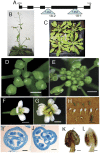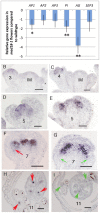Mediator subunit18 controls flowering time and floral organ identity in Arabidopsis
- PMID: 23326539
- PMCID: PMC3543355
- DOI: 10.1371/journal.pone.0053924
Mediator subunit18 controls flowering time and floral organ identity in Arabidopsis
Abstract
Mediator is a conserved multi-protein complex that plays an important role in regulating transcription by mediating interactions between transcriptional activator proteins and RNA polymerase II. Much evidence exists that Mediator plays a constitutive role in the transcription of all genes transcribed by RNA polymerase II. However, evidence is mounting that specific Mediator subunits may control the developmental regulation of specific subsets of RNA polymerase II-dependent genes. Although the Mediator complex has been extensively studied in yeast and mammals, only a few reports on Mediator function in flowering time control of plants, little is known about Mediator function in floral organ identity. Here we show that in Arabidopsis thaliana, MEDIATOR SUBUNIT 18 (MED18) affects flowering time and floral organ formation through FLOWERING LOCUS C (FLC) and AGAMOUS (AG). A MED18 loss-of-function mutant showed a remarkable syndrome of later flowering and altered floral organ number. We show that FLC and AG mRNA levels and AG expression patterns are altered in the mutant. Our results support parallels between the regulation of FLC and AG and demonstrate a developmental role for Mediator in plants.
Conflict of interest statement
Figures






Similar articles
-
early in short days 4, a mutation in Arabidopsis that causes early flowering and reduces the mRNA abundance of the floral repressor FLC.Development. 2002 Dec;129(23):5349-61. doi: 10.1242/dev.00113. Development. 2002. PMID: 12403707
-
TAF15b, involved in the autonomous pathway for flowering, represses transcription of FLOWERING LOCUS C.Plant J. 2018 Jan;93(1):79-91. doi: 10.1111/tpj.13758. Epub 2017 Nov 30. Plant J. 2018. PMID: 29086456
-
Control of reproductive floral organ identity specification in Arabidopsis by the C function regulator AGAMOUS.Plant Cell. 2013 Jul;25(7):2482-503. doi: 10.1105/tpc.113.113209. Epub 2013 Jul 2. Plant Cell. 2013. PMID: 23821642 Free PMC article.
-
The autonomous pathway: epigenetic and post-transcriptional gene regulation in the control of Arabidopsis flowering time.Curr Opin Plant Biol. 2004 Oct;7(5):570-4. doi: 10.1016/j.pbi.2004.07.002. Curr Opin Plant Biol. 2004. PMID: 15337100 Review.
-
Post-translational modifications of FLOWERING LOCUS C modulate its activity.J Exp Bot. 2017 Jan 1;68(3):383-389. doi: 10.1093/jxb/erw431. J Exp Bot. 2017. PMID: 28204510 Review.
Cited by
-
Epigenomics and bolting tolerance in sugar beet genotypes.J Exp Bot. 2016 Jan;67(1):207-25. doi: 10.1093/jxb/erv449. Epub 2015 Oct 13. J Exp Bot. 2016. PMID: 26463996 Free PMC article.
-
The Arabidopsis Mediator Complex Subunit16 Is a Key Component of Basal Resistance against the Necrotrophic Fungal Pathogen Sclerotinia sclerotiorum.Plant Physiol. 2015 Sep;169(1):856-72. doi: 10.1104/pp.15.00351. Epub 2015 Jul 4. Plant Physiol. 2015. PMID: 26143252 Free PMC article.
-
The Mediator complex and transcription regulation.Crit Rev Biochem Mol Biol. 2013 Nov-Dec;48(6):575-608. doi: 10.3109/10409238.2013.840259. Epub 2013 Oct 3. Crit Rev Biochem Mol Biol. 2013. PMID: 24088064 Free PMC article. Review.
-
Functional Analysis of OsMED16 and OsMED25 in Response to Biotic and Abiotic Stresses in Rice.Front Plant Sci. 2021 Mar 31;12:652453. doi: 10.3389/fpls.2021.652453. eCollection 2021. Front Plant Sci. 2021. PMID: 33868352 Free PMC article.
-
Mediator subunit MED31 is required for radial patterning of Arabidopsis roots.Proc Natl Acad Sci U S A. 2018 Jun 12;115(24):E5624-E5633. doi: 10.1073/pnas.1800592115. Epub 2018 May 29. Proc Natl Acad Sci U S A. 2018. PMID: 29844159 Free PMC article.
References
-
- Blazek E, Mittler G, Meisterernst M (2005) The mediator of RNA polymerase II. Chromosoma 113: 399–408. - PubMed
-
- Casamassimi A, Napoli C (2007) Mediator complexes and eukaryotic transcription regulation: an overview. Biochimie 89: 1439–1446. - PubMed
-
- Kornberg RD (2005) Mediator and the mechanism of transcriptional activation. Trends Biochem Sci 30: 235–239. - PubMed
-
- Backstrom S, Elfving N, Nilsson R, Wingsle G, Bjorklund S (2007) Purification of a plant mediator from Arabidopsis thaliana identifies PFT1 as the Med25 subunit. Mol Cell 26: 717–729. - PubMed
Publication types
MeSH terms
Substances
Grants and funding
LinkOut - more resources
Full Text Sources
Other Literature Sources
Molecular Biology Databases

